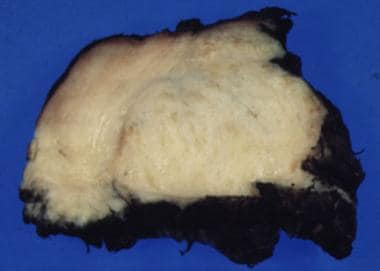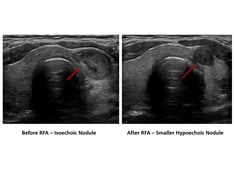Practice Essentials
Riedel thyroiditis, or Riedel's thyroiditis (RT), is a rare, chronic inflammatory disease of the thyroid gland characterized by a dense fibrosis that replaces normal thyroid parenchyma. The fibrotic process invades adjacent structures of the neck and extends beyond the thyroid capsule. This feature differentiates RT from other inflammatory or fibrotic disorders of the thyroid. Extension beyond the thyroid also differentiates this from the fibosing variant of Hashimoto thyroiditis. Gross pathology is shown in the image below. (See Etiology and Workup.)
 Gross pathology of Riedel thyroiditis. The cut edge is avascular, with a characteristic white color. Image courtesy of SL Lee.
Gross pathology of Riedel thyroiditis. The cut edge is avascular, with a characteristic white color. Image courtesy of SL Lee.
Involvement in RT may be unilateral or bilobar. Thyroid function depends on the extent to which the normal thyroid gland has been replaced by fibrotic tissue. Most patients are euthyroid, but hypothyroidism is noted in approximately 30% of cases. Rarely, hyperthyroidism can occur, but this is probably secondary to a coexisting condition. (See Prognosis, Presentation, and Workup.)
Some experts have traditionally believed that RT is not primarily a thyroid disease but rather that it is a manifestation of the systemic disorder multifocal fibrosclerosis. Approximately one third of RT cases are associated with clinical findings of multifocal fibrosclerosis at the time of diagnosis. (See Etiology.)
In 1883, Professor Bernhard Riedel first recognized the disease. He published a description of 2 cases in 1896 and of a third case in 1897. [1] Riedel used the term eisenharte struma to describe the stone-hard consistency of the thyroid gland and its fixation to adjacent structures. He noted the presence of chronic inflammation with fibrosis and the absence of malignancy on microscopic examination. Simple wedge resection of the thyroid isthmus was used to alleviate tracheal obstruction and is still the preferred surgical therapy for RT.
Etiology
The etiology of Riedel thyroiditis (RT) is unknown, but it may be related to a relatively new group of rare disorders, IgG4-related systemic disease (IgG4-RSD). [2] One theory of pathogenesis postulates that RT results from an autoimmune process. A second theory holds RT to be a primary fibrotic disorder. However, IgG4-RSD may unify these 2 seemingly disparate etiologies.
Autoimmune theory
The following evidence supports an autoimmune pathogenesis for RT:
-
The presence of antithyroid antibodies in a significant percentage of patients with RT (67% of 178 cases reviewed in one study) [3]
-
The pathologic features of cellular infiltration, including lymphocytes, plasma cells, and histiocytes
-
The frequent presence of focal vasculitis on pathologic examination
-
The favorable response of a subset of patients with RT to treatment with systemic corticosteroids
However, the presence of normal lymphocyte subpopulations and normal serum complement levels weighs against an autoimmune mechanism. Elevated levels of antithyroid antibodies may merely reflect the immune system's exposure to sequestered antigens released by the destruction of thyroid parenchyma from a primary fibrotic disorder.
Primary fibrotic disorder theory
The theory that RT is a primary fibrotic disorder is supported by its association with multifocal fibrosclerosis. This uncommon idiopathic syndrome is characterized by fibrosis involving multiple organ systems. The extracervical manifestations of multifocal fibrosclerosis can include retroperitoneal fibrosis, mediastinal fibrosis, orbital pseudotumor, pulmonary fibrosis, sclerosing cholangitis, lacrimal gland fibrosis, and fibrous parotitis. RT may be but 1 manifestation of this multifocal disease.
The histopathologic changes of RT closely resemble those observed in multifocal fibrosclerosis. Additionally, one third of published RT cases have demonstrated at least 1 manifestation of extracervical fibrosclerosis. The ability of systemic corticosteroids and tamoxifen to inhibit fibrogenesis accounts for the favorable effect of such treatment in both conditions. [4]
IgG4-RSD disorder
IgG4-RSD is a relatively new group of disorders that share similar presentations. These disorders have in common a preponderance of excess IgG4. The disorders are characterized by lymphoplasmacytic infiltrates containing IgG4-positive plasma cells. [5] These infiltrates ultimately lead to fibrosis and elevated serum levels of IgG4. [6, 7]
Epidemiology
United States
Riedel thyroiditis (RT) is a very rare condition. At the Mayo Clinic, 37 cases of RT were diagnosed in a series of 57,000 thyroidectomies performed between 1920 and 1984, for an incidence of 0.06%. The overall incidence among outpatients was 1.6 cases per 100,000 population. Based on large databases in referral centers, it appears that over the previous decades, the incidence of RT has been decreasing.
Race-, sex-, and age-related demographics
Although predominantly reported in whites, RT has been described in all races. RT is most often seen in women; in a review of 178 patients with RT, 83% were female. In the same study, the mean age at diagnosis of RT was 47.8 years (range, 23-77 y). [3]
Prognosis
Riedel thyroiditis (RT) is generally a self-limited disease with a favorable prognosis. Death due to airway compromise is very rare in treated patients. Occasionally, spontaneous remission has been reported. Patients can also relapse.
In RT, morbidity is most frequently related to local compressive symptoms, such as dysphagia, dyspnea, hoarseness, and cough. Hypothyroidism is present in 30% of cases. Fibrotic invasion of adjacent anatomic structures may infrequently result in symptoms related to recurrent laryngeal nerve paralysis or hypoparathyroidism.
One third of patients with RT ultimately develop at least 1 extracervical manifestation of multifocal fibrosclerosis (such as retroperitoneal fibrosis, mediastinal fibrosis, or sclerosing cholangitis). [8] In such patients, the prognosis essentially becomes that of extracervical fibrosclerosis. Therefore, when RT is diagnosed, it is essential to perform abdominal and chest imaging studies to exclude concomitant, extracervical entities from multifocal fibrosclerosis. Fibrosclerosis of the surrounding tissue by RT can lead to serious morbidity and death.
A retrospective institutional review of a rare form of invasive thyroiditis from the Mayo Clinic discussed the common presenting symptoms and extrathyroidal involvement of the systemic fibrosclerosis. Treatments used in the 21 reported patients included partial thyroidectomy, tamoxifen, and corticosteroid therapy. Other, less well validated studies include mycophenolate mofetil [9] and rituximab. [10] Of note, no cause-specific mortality was noted, and the fibrotic process stabilized or partially resolved in all patients. [4]
Complications
Because of the encroachment beyond the thyroid capsule, nonthyroid problems can be associated with RT. Complications of Riedel thyroiditis can include the following:
-
Airway obstruction
-
Dysphonia
-
Hoarseness - Due to recurrent laryngeal involvement
-
Hypothyroidism
-
Hypoparathyroidism
-
Dysphagia
-
Stridor - Due to tracheal compression
-
Gross pathology of Riedel thyroiditis. The cut edge is avascular, with a characteristic white color. Image courtesy of SL Lee.
-
Riedel thyroiditis. The atrophic thyroid follicles are surrounded by a dense, inflammatory infiltrate composed of lymphocytes, plasma cells, and eosinophils and accompanied by dense fibrosis. The wide bands of keloid-type collagen located between the individual follicles and surrounding clusters are a common feature of this condition.
-
Riedel thyroiditis. This vein shows infiltration of its wall by a heavy, inflammatory infiltrate.
-
Riedel thyroiditis. The inflammatory infiltrate and dense, pink bands of fibrosis can obliterate thyroid follicles. Image courtesy of SL Lee.







